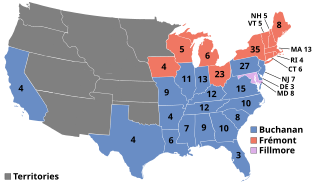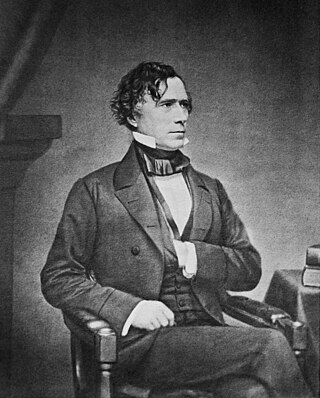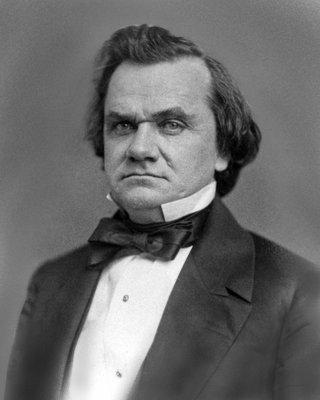
Andrew Johnson was the 17th president of the United States, serving from 1865 to 1869. He assumed the presidency following the assassination of Abraham Lincoln, as he was vice president at that time. Johnson was a Democrat who ran with Lincoln on the National Union Party ticket, coming to office as the Civil War concluded. He favored quick restoration of the seceded states to the Union without protection for the newly freed people who were formerly enslaved. This led to conflict with the Republican-dominated Congress, culminating in his impeachment by the House of Representatives in 1868. He was acquitted in the Senate by one vote.

The Kansas–Nebraska Act of 1854 was a territorial organic act that created the territories of Kansas and Nebraska. It was drafted by Democratic Senator Stephen A. Douglas, passed by the 33rd United States Congress, and signed into law by President Franklin Pierce. Douglas introduced the bill intending to open up new lands to develop and facilitate the construction of a transcontinental railroad. However, the Kansas–Nebraska Act effectively repealed the Missouri Compromise, stoking national tensions over slavery and contributing to a series of armed conflicts known as "Bleeding Kansas".

The 1856 United States presidential election was the 18th quadrennial presidential election, held on Tuesday, November 4, 1856. In a three-way election, Democrat James Buchanan defeated Republican nominee John C. Frémont and Know Nothing nominee Millard Fillmore. The main issue was the expansion of slavery as facilitated by the Kansas–Nebraska Act of 1854. Buchanan defeated President Franklin Pierce at the 1856 Democratic National Convention for the nomination. Pierce had become widely unpopular in the North because of his support for the pro-slavery faction in the ongoing civil war in territorial Kansas, and Buchanan, a former Secretary of State, had avoided the divisive debates over the Kansas–Nebraska Act by being in Europe as the Ambassador to the United Kingdom.

The 1860 United States presidential election was the 19th quadrennial presidential election, held on Tuesday, November 6, 1860. In a four-way contest, the Republican Party ticket of Abraham Lincoln and Hannibal Hamlin, absent from the ballot in ten slave states, won a national popular plurality, a popular majority in the North where states already had abolished slavery, and a national electoral majority comprising only Northern electoral votes. Lincoln's election thus served as the main catalyst of the states that would become the Confederacy seceding from the Union. This marked the first time that a Republican was elected president. It was also the first presidential election in which both major party candidates were registered in the same home state; the others have been in 1904, 1920, 1940, 1944, and 2016.

The Compromise of 1850 was a package of five separate bills passed by the United States Congress in September 1850 that temporarily defused tensions between slave and free states in the years leading up to the American Civil War. Designed by Whig senator Henry Clay and Democratic senator Stephen A. Douglas, with the support of President Millard Fillmore, the compromise centered on how to handle slavery in recently acquired territories from the Mexican–American War (1846–48).

The Homestead Acts were several laws in the United States by which an applicant could acquire ownership of government land or the public domain, typically called a homestead. In all, more than 160 million acres of public land, or nearly 10 percent of the total area of the United States, was given away free to 1.6 million homesteaders; most of the homesteads were west of the Mississippi River.

Historians who address the origins of the American Civil War agree that the preservation of the institution of slavery was the principal aim of the 11 Southern states that declared their secession from the United States and united to form the Confederate States of America. However, while historians in the 21st century agree on the centrality of the conflict over slavery—it was not just "a cause" of the war but "the cause" according to Civil War historian Chris Mackowski—they disagree sharply on which aspects of this conflict were most important, and on the North’s reasons for refusing to allow the Southern states to secede. Proponents of the pseudo-historical Lost Cause ideology have denied that slavery was the principal cause of the secession, a view that has been disproven by the overwhelming historical evidence against it, notably the seceding states' own secession documents.

In the United States before 1865, a slave state was a state in which slavery and the internal or domestic slave trade were legal, while a free state was one in which they were prohibited. Between 1812 and 1850, it was considered by the slave states to be politically imperative that the number of free states not exceed the number of slave states, so new states were admitted in slave–free pairs. There were, nonetheless, some slaves in most free states up to the 1840 census, and the Fugitive Slave Act of 1850 specifically stated that a slave did not become free by entering a free state.

Forty acres and a mule was part of Special Field Orders No. 15, a wartime order proclaimed by Union General William Tecumseh Sherman on January 16, 1865, during the American Civil War, to allot land to some freed families, in plots of land no larger than 40 acres (16 ha). Sherman later ordered the army to lend mules for the agrarian reform effort. The field orders followed a series of conversations between Secretary of War Edwin M. Stanton and Radical Republican abolitionists Charles Sumner and Thaddeus Stevens following disruptions to the institution of slavery provoked by the American Civil War. Many freed people believed, after being told by various political figures, that they had a right to own the land they had been forced to work as slaves and were eager to control their own property. Freed people widely expected to legally claim 40 acres of land. However, Abraham Lincoln's successor as president, Andrew Johnson, tried to reverse the intent of Sherman's wartime Order No. 15 and similar provisions included in the second Freedmen's Bureau bills.

In the United States the period 1848 and 1865 was dominated by the tensions that led to the American Civil War between North and South, and the bloody fighting in 1861-1865 that produced Northern victory in the war and ended slavery. At the same time industrialization and the transportation revolution changed the economics of the Northern United States and the Western United States. Heavy immigration from Western Europe shifted the center of population further to the North.
The Southern Homestead Act of 1866 is a United States federal law enacted to break a cycle of debt during the Reconstruction following the American Civil War. Prior to this act, blacks and whites alike were having trouble buying land. Sharecropping and tenant farming had become ways of life. This act attempted to solve this by selling land at low prices so Southerners could buy it. Many people, however, could still not participate because the low prices were still too high.
The "Slave Reparations Act" is a tax fraud related to the concept of reparations for slavery. The scam claims that filers can receive $5,000 or increased social security payouts for African-Americans born in the United States between 1911 and 1926.

The Slave Power, or Slavocracy, referred to the perceived political power held by American slaveowners in the federal government of the United States during the Antebellum period. Antislavery campaigners, led by Frederick Douglass, during this period bitterly decried what they saw as disproportionate and corrupt influence wielded by wealthy Southerners. The argument was that this small group of wealthy enslavers had seized political control of their states and were trying to take over the federal government illegitimately to expand and protect slavery. The argument was later widely used by the Republican Party that formed in 1854–55 to oppose the expansion of slavery.

South Carolina was the first state to secede from the Union in December 1860, and was one of the founding member states of the Confederacy in February 1861. The bombardment of the beleaguered U.S. garrison at Fort Sumter in Charleston Harbor on April 12, 1861, is generally recognized as the first military engagement of the war. The retaking of Charleston in February 1865, and raising the flag again at Fort Sumter, was used for the Union symbol of victory.
Historiography examines how the past has been viewed or interpreted. Historiographic issues about the American Civil War include the name of the war, the origins or causes of the war, and President Abraham Lincoln's views and goals regarding slavery.

The presidency of Franklin Pierce began on March 4, 1853, when Franklin Pierce was inaugurated, and ended on March 4, 1857. Pierce, a Democrat from New Hampshire, took office as the 14th United States president after routing Whig Party nominee Winfield Scott in the 1852 presidential election. Seen by fellow Democrats as pleasant and accommodating to all the party's factions, Pierce, then a little-known politician, won the presidential nomination on the 49th ballot of the 1852 Democratic National Convention. His hopes for reelection ended after losing the Democratic nomination at the 1856 Democratic National Convention.

The presidency of James Buchanan began on March 4, 1857, when James Buchanan was inaugurated as 15th president of the United States, and ended on March 4, 1861. Buchanan, a Democrat from Pennsylvania, took office as the 15th United States president after defeating former President Millard Fillmore of the American Party, and John C. Frémont of the Republican Party in the 1856 presidential election.

James Buchanan Jr. was an American lawyer, diplomat, and politician who served as the 15th president of the United States from 1857 to 1861. He previously served as secretary of state from 1845 to 1849 and represented Pennsylvania in both houses of the U.S. Congress. He was an advocate for states' rights, particularly regarding slavery, and minimized the role of the federal government preceding the Civil War.

Stephen Arnold Douglas was an American politician and lawyer from Illinois. A senator, he was one of two nominees of the badly split Democratic Party for president in the 1860 presidential election, which was won by Republican candidate Abraham Lincoln. Douglas had previously defeated Lincoln in the 1858 United States Senate election in Illinois, known for the pivotal Lincoln–Douglas debates. He was one of the brokers of the Compromise of 1850 which sought to avert a sectional crisis; to further deal with the volatile issue of extending slavery into the territories, Douglas became the foremost advocate of popular sovereignty, which held that each territory should be allowed to determine whether to permit slavery within its borders. This attempt to address the issue was rejected by both pro-slavery and anti-slavery advocates. Douglas was nicknamed the "Little Giant" because he was short in physical stature but a forceful and dominant figure in politics.
Black land loss in the United States refers to the loss of land ownership and rights by Black people residing or farming in the United States. In 1862, the United States government passed the Homestead Act. This Act gave certain Americans seeking farmland the right to apply for ownership of government land or the public domain. This newly acquired farmland was typically called a homestead. In all, more than 160 million acres of public land, or nearly 10 percent of the total area of the United States was given away free to 1.6 million homesteaders. However, until the United States abolished slavery in 1865 and the passage of the 14th amendment in 1868, enslaved and free Blacks could not benefit from these acts. According to data published by the National Park Service and the University of Nebraska, some 6000 homesteads of an average of 160 acres were issued to Blacks in the years immediately following the war.















